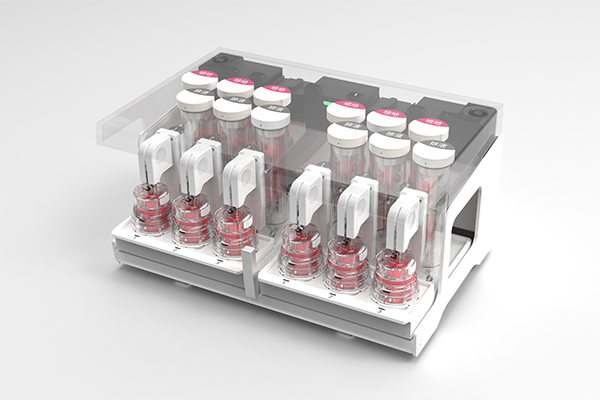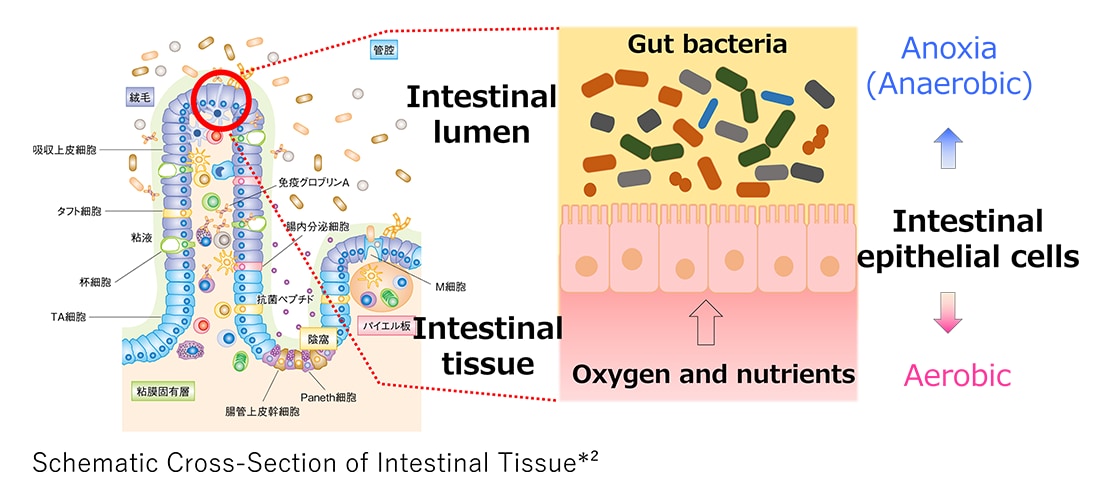June 22, 2023 | News & Notices
Co-Culture of Intestinal Epithelial Cells and Gut Bacteria in the Artificially Reproduced Intestinal Environment
Commencing Trial Sales of Gut Bacteria Co-Culture Device
On June 22, Shimadzu Corporation commenced trial sales of its Gut Bacteria Co-Culture Device (hereinafter “the Device”). The Device creates the mimicked environment of the human gut that allows the co-culture*1 of intestinal epithelial cells and gut bacteria. The technologies used in the Device were developed through the joint research with Professor Takane Katayama of the Graduate School of Biostudies, Kyoto University. On April 13 of this year, the research using the Device by Morinaga Milk Industry Co., Ltd. was published in the scientific journal “Frontiers in Microbiology”. Shimadzu also plans to present and exhibit the results of the joint research on the Device with Professor Katayama of the Kyoto University, and Professors Koji Hase and Kim Yungi of the Faculty of Pharmacy, Keio University at “The 27th Annual Meeting of Intestinal Microbiology Society” held on June 27 to 28.

Photograph: Gut Bacteria Co-Culture Device
Gut bacteria synthesize acetic acid, vitamins, and various other substances that act on the surface of the gut (intestinal epithelial cells), through the metabolism of sugars, amino acids, and dietary fiber. In human guts, intestinal epithelial cells form a barrier between an aerobic environment that oxygen is supplied to the intestinal epithelial cells from the blood, and a hypoxic (anaerobic) environment conducive to the growth of gut bacteria. Both these environments must be reproduced to evaluate interactions between intestinal epithelial cells and gut bacteria. The Device creates the conditions that approach the actual human gut, allowing to investigate interactions between intestinal epithelial cells and gut bacteria.

The Device consists of original culture vessels (patent pending), culture medium flow controller, and transepithelial electrical resistance (TEER*3) measuring instruments. A sheet of intestinal epithelial cells cultured in a 12-well cell culture insert is fitted in the culture vessel, where gut bacteria with bacterial culture medium is placed on the “intestinal lumen side”, and cell culture medium on the “intestinal tissue side”. An anaerobic environment is maintained by placing the Device in an anaerobic chamber*4 while an aerobic environment is also maintained in the cell culture medium by sealing the vessel with dissolved oxygen inside. Fresh bacterial culture medium can be supplied continuously that avoid excessive growth of gut bacteria, therefore enables co-cultures with cells for extended periods of up to three days. The status of intestinal epithelial cells can also be monitored during an experiment by measuring TEER.
On the co-culture experiments using the Device, the bacterial culture medium can be examined to obtain information on which metabolites were produced and how the number of gut bacteria changed, and as the cell culture medium on substances that penetrate the intestinal epithelial cells to be taken up into the body. A comprehensive analysis of these substances by a high-performance liquid chromatograph-mass spectrometer (LC-MS) or gas chromatograph-mass spectrometer (GC-MS) can then provide further insight in metabolite analysis, gene expression in cells, and other phenomena.
By making this Device available to customers, Shimadzu is expecting to advance research undertaken by research institutions and food manufacturers to develop of functional foods and other products utilizing gut bacteria.

Shimadzu is pleased to commence trial sales of the Gut Bacteria Co-Culture Device to researchers and research institutions. The suggested sales price of the Device is from 4 million yen. Please use the form below for inquiries.
- Note
- *1: Batch culture of multiple cell tumors and tissues.
- *2: Excerpted from “Fig. 1 Intestinal Epithelial Cells and Immunocompetent Cells in the Small Intestine” http://leading.lifesciencedb.jp/5-e007
- *3: Trans-endothelial electrical resistance. Used to evaluate cell barrier function and confirm whether cells are dead.
- *4: A machine that keeps a space oxygen-free.
Related Link
Morinaga Milk Industry Co., Ltd. press release: Production of Useful Metabolites Increased by Co-Culture of Bifidobacterium Breve MCC1274 with Human iPS-Derived Intestinal Epithelial Cells —Published in Scientific Journal “Frontiers in Microbiology”—| News Release | Morinaga Milk Industry Co., Ltd. (morinagamilk.co.jp)


